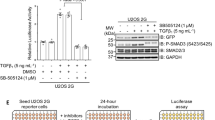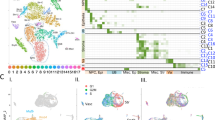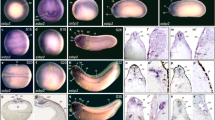Abstract
Hepatocyte growth factor (HGF) induces a three-phase response leading to the formation of branched tubular structures in epithelial cells1,2. The HGF receptor tyrosine kinase works through a Src homology (SH2) docking site that can activate several signalling pathways3. The first phase of the response (scattering), which results from cytoskeletal reorganization, loss of intercellular junctions and cell migration4, is dependent on phosphatidylinositol-3-OH kinase and Rac activation5,6. The second phase (growth) requires stimulation of the Ras–MAP kinase cascade7. Here we show that the third phase (tubulogenesis) is dependent on the STAT pathway. HGF stimulates recruitment of Stat-3 to the receptor, tyrosine phosphorylation, nuclear translocation and binding to the specific promoter element SIE. Electroporation of a tyrosine-phosphorylated peptide, which interferes with both the association of STAT to the receptor and STAT dimerization, inhibits tubule formation in vitro without affecting either HGF-induced ‘scattering’ or growth. The same result is obtained using a specific ‘decoy’ oligonucleotide that prevents STAT from binding to DNA and affecting the expression of genes involved in cell-cycle regulation (c-fos and waf-1). Activation of signal transducers that directly control transcription is therefore required for morphogenesis.
This is a preview of subscription content, access via your institution
Access options
Subscribe to this journal
Receive 51 print issues and online access
$199.00 per year
only $3.90 per issue
Buy this article
- Purchase on Springer Link
- Instant access to full article PDF
Prices may be subject to local taxes which are calculated during checkout




Similar content being viewed by others
References
Medico, E. et al. The tyrosine kinase receptors Ron and Sea control “scattering” and morphogenesis of liver progenitor cells in vitro. Mol. Biol. Cell 7, 495–504 (1996).
Sachs, M. et al. Mitogenic and morphogenic activity of epithelial receptor tyrosine kinases. J. Cell Biol. 133, 1095–1107 (1996).
Ponzetto, C. et al. Amultifunctional docking site mediates signalling and transformation by the Hepatocyte Growth Factor/Scatter Factor receptor family. Cell 77, 261–271 (1994).
Stocker, M., Gherardi, E., Perryman, M. & Gray, J. Scatter factor is a fibroblast-derived modulator of epithelial cell motility. Nature 327, 239–242 (1987).
Ridley, A. J., Comoglio, P. M. & Hall, A. Regulation of Scatter Factor/Hepatocyte Growth Factor responses by Ras, Rac, and Rho in MDCK cells. J. Cell Biol. 15, 1110–1122 (1995).
Royal, I. & Park, M. Hepatocyte Growth Factor-induced scatter of Madin–Darby canine kidney cells requires phosphatidylinositol 3-kinase. J. Biol. Chem. 270, 27780–27787 (1995).
Ponzetto, C. et al. Specific uncoupling of GRB2 from the Met receptor. J. Biol. Chem. 271, 14119–14123 (1996).
Pawson, T. Protein modules and signalling networks. Nature 373, 573–580 (1995).
Pelicci, G. et al. The motogenic and mitogenic responses to HGF are amplified by the Shc adaptor protein. Oncogene 10, 1631–1638 (1995).
Weidner, K. M. et al. Interaction between Gab1 and the c-Met receptor tyrosine kinase is responsible for epithelial morphogenesis. Nature 384, 173–176 (1996).
Graziani, A., Gramaglia, D., Cantley, L. C. & Comoglio, P. M. The tyrosine-phosphorylated hepatocyte growth factor/scatter factor receptor associates with phosphatidylinositol 3-kinase. J. Biol. Chem. 266, 22087–22090 (1991).
Ponzetto, C. et al. Anovel recognition motif for Phosphatidylinositol 3-kinase binding mediates its association with the Hepatocyte Growth Factor/Scatter Factor receptor. Mol. Cell Biol. 13, 4600–4608 (1993).
Graziani, A., Gramaglia, D., dalla Zonca, P. & Comoglio, P. M. Hepatocyte Growth Factor/Scatter Factor stimulates the Ras-guanine nucleotide exchanger. J. Biol. Chem. 268, 9165–9168 (1993).
Schindler, C. & Darnell, J. E. J Transcriptional responses to polypeptide ligands: the JAK-STAT pathway. Annu. Rev. Biochem. 64, 621–651 (1995).
Ihle, J. N. STATs: signal transducers and activators of transcription. Cell 84, 221–334 (1996).
Leaman, D. W. et al. Roles of JAKs in activation of STATs and stimulation of c-fos gene expression by Epidermal Growth Factor. Mol. Cell. Biol. 16, 369–375 (1996).
Silvennoinen, O., Ihle, J. N., Schlessinger, J. & Levy, D. E. Interferon-induced nuclear signalling by Jak protein tyrosine kinases. Nature 366, 583–585 (1993).
Wagner, B. J., Hayes, T. E., Hoban, C. J. & Cochran, B. H. The SIF binding element confers sis/PDGF inductibility onto the c-fos promoter. EMBO J. 9, 4477–4484 (1990).
Durbin, J. E., Hackenmiller, R., Simon, M. C. & Levy, D. E. Targeted disruption of the mouse Stat1 gene results in compromised innate immunity to viral disease. Cell 84, 443–450 (1996).
Liu, X. et al. Stat5a is mandatory for adult mammary gland development and lactogenesis. Genes Dev. 11, 179–186 (1967).
Takeda, K. et al. Targeted disruption of the mouse Stat3 gene leads to early embryonic lethality. Proc. Natl Acad. Sci. USA 94, 3801–3804 (1997).
Chin, Y. E. et al. Cell growth arrest and induction of cyclin-dependent kinase inhibitor p21WAF1/CIP1 mediated by STAT1. Science 272, 719–722 (1996).
Boccaccio, C., Gaudino, G., Gambarotta, G., Galimi, F. & Comoglio, P. M. Hepatocyte Growth factor (HGF) receptor expression is inducible and is part of the delayed-early response to HGF. J. Biol. Chem. 269, 12846–12851 (1994).
Lucibello, F. C., Lowag, C., Neuberg, M. & Muller, R. Trans-repression of the mouse c-fos promoter: a novel mechanism of Fos-mediated trans-regulation. Cell 59, 999–1007 (1989).
Giordano, S., Ponzetto, C., Di Renzo, M. F., Cooper, C. S. & Comoglio, P. M. Tyrosine kinase receptor indistinguishable from the c-Met protein. Nature 339, 155–156 (1989).
Gilman, M. Z., Wilson, R. N. & Weinberg, R. A. Multiple protein binding sites in the 5′-flanking region regulate c-fos expression. Mol. Cell. Biol. 6, 4305–4316 (1986).
El-Deiry, W. S. et al. WAF-1, a potential mediator of p53 tumor suppression. Cell 75, 817–825 (1993).
Gambarotta, G. et al. Ets up-regulates MET transcription. Oncogene 13, 1911–1917 (1996).
Raptis, L. H., Liu, S. K. W., Firth, K. L., Stiles, C. D. & Alberta, J. A. Electroporation of peptides into adherent cells in situ. Biotechniques 19, 104–114 (1995).
Comoglio, P. M. et al. Detection of phosphotyrosine containing proteins in the detergent insoluble fraction of RSV-transformed fibroblasts by azobenzene phosphonate antibodies. EMBO J. 3, 483–489 (1984).
Acknowledgements
We thank P. Giordano (Pharmacia & Upjohn) for peptide synthesis; C. Ponzetto for discussions; A. Cignetto for secretarial help; and E. Wright for help with the manuscript. This work was supported by an AIRC grant to P.M.C. M.A. is recipient of a FIRC Fellowship.
Author information
Authors and Affiliations
Corresponding author
Rights and permissions
About this article
Cite this article
Boccaccio, C., Andò, M., Tamagnone, L. et al. Induction of epithelial tubules by growth factor HGF depends on the STAT pathway. Nature 391, 285–288 (1998). https://doi.org/10.1038/34657
Received:
Accepted:
Issue Date:
DOI: https://doi.org/10.1038/34657
This article is cited by
-
Metabolic alterations in hereditary and sporadic renal cell carcinoma
Nature Reviews Nephrology (2024)
-
Cellular population dynamics shape the route to human pluripotency
Nature Communications (2023)
-
Translation of circHGF RNA encodes an HGF protein variant promoting glioblastoma growth through stimulation of c-MET
Journal of Neuro-Oncology (2023)
-
Cellular crosstalk during liver regeneration: unity in diversity
Cell Communication and Signaling (2022)
-
Targeting Angiogenic Factors for the Treatment of Medulloblastoma
Current Treatment Options in Oncology (2022)
Comments
By submitting a comment you agree to abide by our Terms and Community Guidelines. If you find something abusive or that does not comply with our terms or guidelines please flag it as inappropriate.



